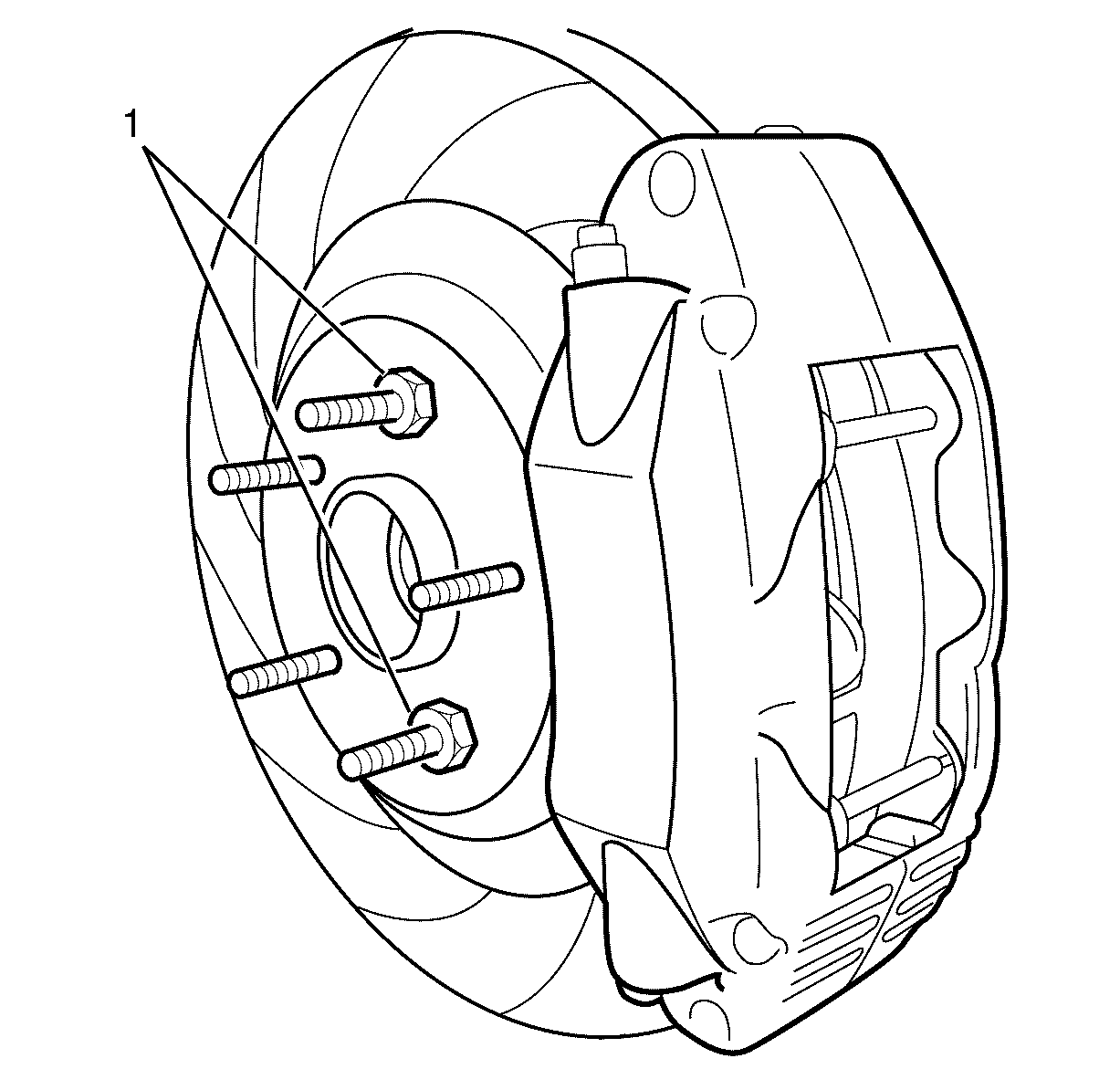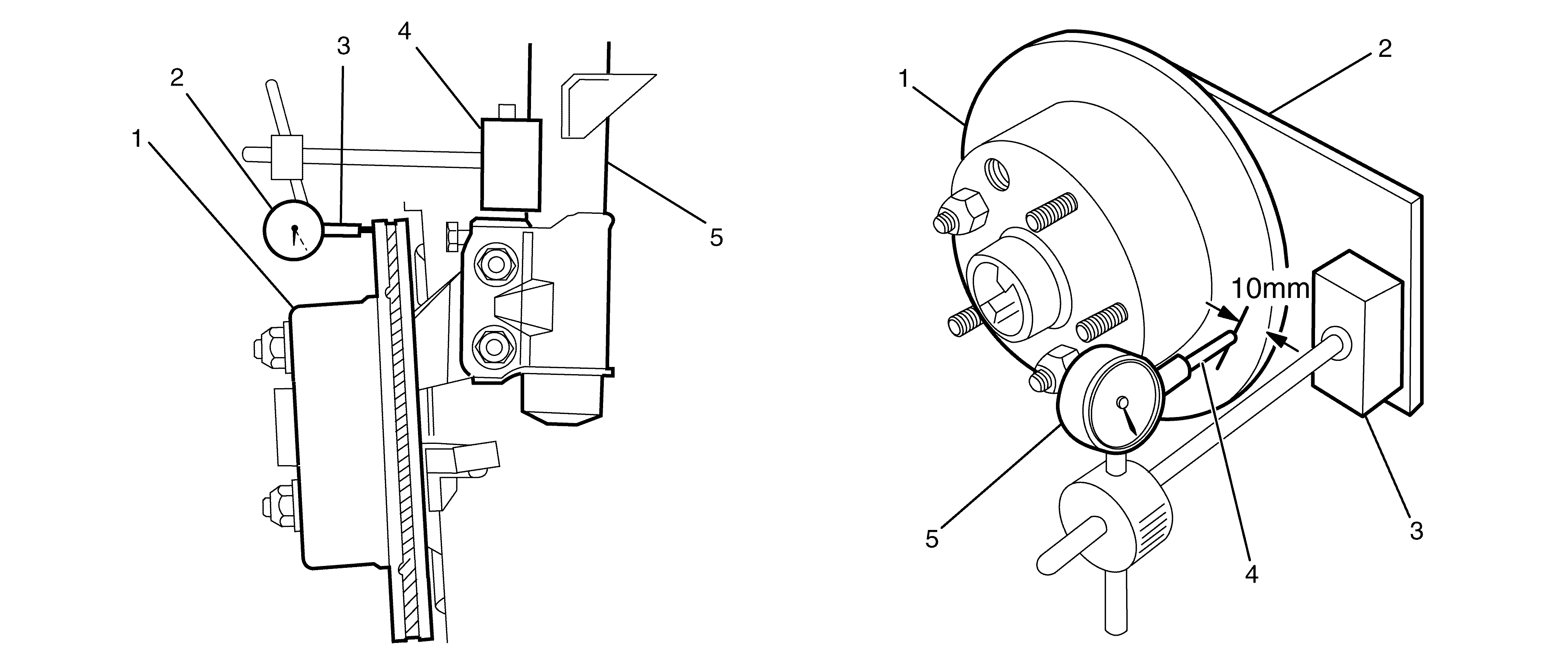Tools Required
| • | J 26900-12 Dial Indicator |
| • | J 26900-13 Magnetic Indicator Base |
| • | J 23738-A Hand Vacuum Pump |
- Inspect the brake fluid level in the brake master cylinder reservoir.
- If required, use J 23738-A to remove some brake fluid until the brake fluid level is midway between the maximum brake fluid level marking and the minimum brake fluid level marking.
- Raise and support the vehicle. Refer to Lifting and Jacking the Vehicle.
- Remove the wheel. Refer to Tire and Wheel Removal and Installation.
- Remove the brake caliper. Refer to:
- Inspect the brake rotor thickness variation. Refer to Brake Rotor Thickness Variation Measurement.
- Index the position of the brake disc to the wheel studs.
- Inspect for corrosion, foreign particles, rust or debris between the wheel hub/axle flange and the brake disc mating surfaces. If the wheel hub/axle flange and/or brake disc mating surfaces exhibit any of these conditions, perform the following steps:
- Install 2 opposite wheel nuts (1), with the flat side of the wheel nut against the brake rotor to retain the brake rotor to the wheel hub.
- Mount a dial indicator assembly to the front strut assembly (5) and position the dial indicator button (3) 10 mm (3/8 in) from the outer edge of the brake disc so that it contacts the brake disc friction surface at a 90 degree angle.
- Bolt the dial indicator plate (2) to the brake caliper mountings on the rear knuckle. Mount a dial indicator assembly on the dial indicator plate (2).
- Rotate the brake disc until the lowest reading is displayed on the indicator dial. Set the dial to zero.
- Rotate the brake disc again until the highest reading is displayed on the dial. Mark the location of the high spot.
- Compare the brake disc assembled LRO to the following specification:
- If the brake disc assembled LRO measurement exceeds the specification, refer to Brake Rotor Assembled Lateral Runout Correction.
- If the brake disc assembled LRO measurement is within specification, install the brake caliper. Refer to:
- Install the wheel. Refer to Tire and Wheel Removal and Installation.
- Lower the vehicle to the ground.
Warning: Refer to Brake Fluid Irritant Warning in the Preface section.
Caution: Refer to Brake Fluid Effects on Paint and Electrical Components Caution in the Preface section.
Note: Do not completely empty the brake master cylinder reservoir.
Note: The brake fluid level must be midway between the maximum brake fluid level marking and the minimum brake fluid level marking.
Warning: Refer to Safety Glasses Warning in the Preface section.
Danger: To avoid any vehicle damage, serious personal injury or death when major components are removed from the vehicle and the vehicle is supported by a hoist, support the vehicle with jack stands at the opposite end from which the components are being removed and strap the vehicle to the hoist.
Caution: This brake caliper is coated with a specialized paint. Use care when handling and servicing to ensure the paint does not get chipped or scratched. Clean any brake fluid from painted surfaces with denatured alcohol, or equivalent, as soon as possible.
Note:
• Brake disc assembled lateral runout (LRO) exceeding the maximum allowable
specification can cause the brake disc to develop thickness variation over time, usually
between 10,000 [dash ] 20,000 km (6,200 [dash ] 12,400 mi). • BRAKE DISC THICKNESS VARIATION MUST BE VERIFIED BEFORE INSPECTING THE
ASSEMBLED LRO.
Warning: Refer to Brake Dust Warning in the Preface section.
Note: Whenever the brake disc has been separated from the hub/axle flange, any rust or contaminants between the mating surfaces of the hub/axle flange and the brake disc must be cleaned. Failure to comply may result in assembled LRO of the brake disc.
| 8.1. | Remove the brake disc from the vehicle. Refer to: |
| 8.2. | Clean any rust or corrosion from the mating surface of the hub/axle flange. |
| 8.3. | Clean any rust or corrosion from the mating surface of the brake disc. |
| 8.4. | Clean the friction surfaces of the brake disc with denatured alcohol, or an equivalent approved brake cleaner. |
| 8.5. | Install the brake disc to the hub/axle flange. Refer to Front Brake Rotor Replacement. |


Note: To measure the front brake disc (1) assembled LRO, refer to view A. Set up a dial indicator (2) J 26900-12 on a magnetic mounting base (4) J 26900-13 and attach the dial indicator assembly to the front strut assembly (5).
Note: To measure the rear brake disc (1) assembled LRO, refer view B. Set up a dial indicator (5) J 26900-12 on a magnetic mounting base (3) J 26900-13 and attach the dial indicator assembly to the dial indicator plate (2).
Specification
| • | Front brake disc maximum allowable assembled lateral runout: 0.05 mm (0.002 in). |
| • | Rear brake disc maximum allowable assembled lateral runout: 0.05 mm (0.002 in). |
